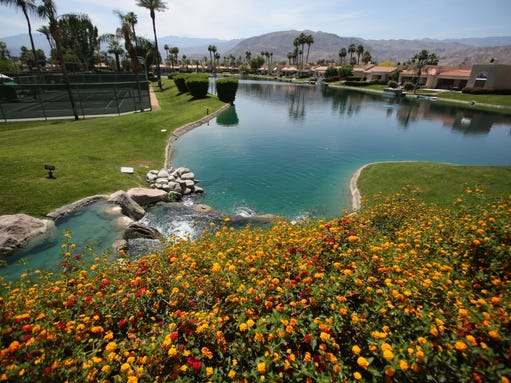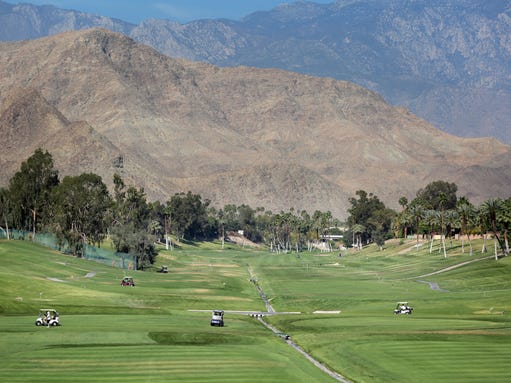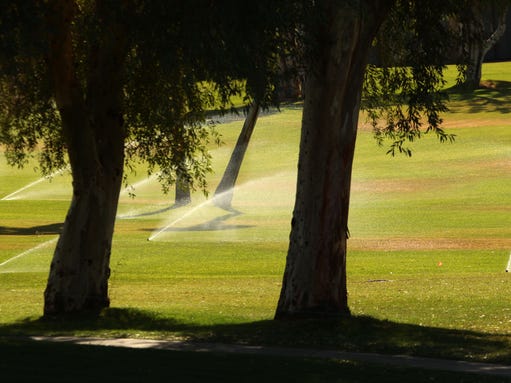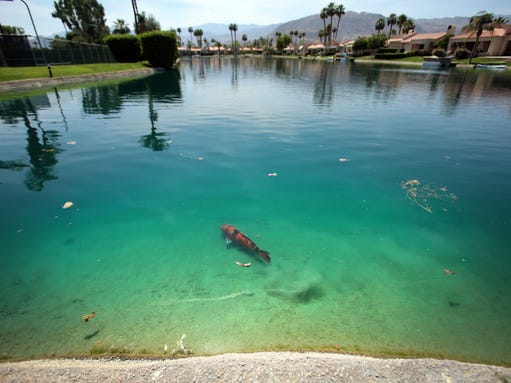Facing drought in an oasis of golf courses and lakes - USA TODAY
For golf courses and resort communites like Lake Mirage, water is the lifeblood that makes the area attractive. Jon Roy, the community manager, explains why the area is still lush, and water still flowing, despite California's drought. VPC
PALM SPRINGS, Calif. â€" The gated community of Lake Mirage Racquet Club is built around water. Waterfalls cascade down into pools at the front gates. Ducks and swans float in artificial lakes. Every home has a lakefront view, and pontoon boats are moored at docks along the shore.
This may be the middle of the desert during one of the worst droughts ever recorded in California, but the grass is still green and water is still gushing into ponds across the Coachella Valley. For golf courses, resorts and lush communities like Lake Mirage in Rancho Mirage, water is the lifeblood of the desert oasis aesthetic that has long made the area attractive to retirees and tourists from greener places. And change does not come easily.
With Gov. Jerry Brown now ordering a mandatory 25% cut in statewide water use, those measures are putting growing pressures on resorts, homeowner associations and golf courses to pitch in and do their part to save more water. Doing that on a large scale, however, is likely to be costly and challenging because many homeowners on the fringes of grassy landscapes aren't interested in seeing brown turf or dry lakes outside their windows.
And while details of the new drought measures have yet to be worked out, many desert golf courses and large homeowner associations may fall under a gray area and not be bound by the rules since they use irrigation water from their own private wells rather than from public water suppliers. Still, several managers of golf courses and homeowner associations said they intend to do everything they can to live up to the governor's call.
Jon Roy, the community manager at Lake Mirage, said the 25% target seems difficult to achieve in the area, for various reasons.
"We'll try our best. It's a tough one," Roy said. "We have 11 pools and spas. We have 19 acres of lakes. So again, the evaporation rate is the hard part to overcome."
Standing beside a pond, Roy explained how the community has been investing for years in reducing its water footprint, mainly by replacing portions of turf with desert landscaping. The association plans to apply for funding from the local water district this year to remove more grass.
Much of the water that's pumped from the community's well flows to the lakes, Roy said, and some of that ends up percolating back underground.
"Yes, it is a fair amount of water, but it is water that we're actually paying for to have pumped from our own property," he said. "And a lot of it is going back into the aquifer."

The 238-home community of Lake Mirage in Rancho Mirage features 19 acres of lakes and also has 11 pools and spas. (Photo: Richard Lui/The Desert Sun)
Groundwater levels in the area have been declining for decades. But Roy said the homeowner association has been proactive about looking for ways to save significant amounts of water.
Asked if the association might consider draining the lakes, he grinned and said: "I think we have static in our line. I didn't hear that question."
The community of 238 homes was built in the 1980s on what used to be a date farm. Some residents say they moved here to enjoy the lakes, where people can take sunset cruises on their pontoon boats.
Communities in the Palm Springs area have long marketed themselves to newcomers with images of lakes and rolling green hills set against the dry mountains. Those expectations live on even during the extreme drought. Some homeowners living next to golf courses, for instance, have complained about plans to convert the fringes of fairways to desert landscaping.
"It's hard because people do want a lot of lawns, and it's expensive to convert. … You can't just put sand in and say, 'Hey, we did it,'" Roy said. "It is a tough one. And the 25% thing, when I read it this morning, I was like, 'Yeah, right.'"
Parts of the Coachella Valley have long had some of the highest per-capita water use in California, and also relatively low water rates.
State figures in January, for instance, showed that the small private supplier Myoma Dunes Mutual Water Company, which serves more than 6,000 people in Bermuda Dunes and surrounding areas, ranked No. 1 in California with per-capita water use of 342 gallons per person per day. The Coachella Valley Water District ranked No. 3 in the state at 238 gallons per person a day, while Palm Springs-based Desert Water Agency was also in the top 10 at 201 gallons a day â€" all far above the statewide per-capita average of 73 gallons a day in January.
The area's water agencies say the desert heat leads to more water use outdoors and that the numbers are skewed because census figures leave out many seasonal residents. Nevertheless, water managers in the Coachella Valley have generally agreed that more can be done to boost conservation, especially given the severity of the drought.
The new mandatory drought measures, which Brown laid out in an executive order on Wednesday, call for the State Water Resources Control Board to impose restrictions to achieve a 25% statewide reduction "in potable urban water usage." That leaves out non-potable water sources, such as recycled water, which is used to irrigate some of the Coachella Valley's 123 golf courses.
The governor's order calls for the State Water Board to impose restrictions aimed at cutting the use of potable water by golf courses, cemeteries and other types of properties. But the Coachella Valley Water District says that doesn't appear to apply directly to golf courses or other properties that pump groundwater from their own wells.
"CVWD's interpretation is that private well owners are exempt from the governor's order, but that doesn't mean that they can't voluntarily meet those restrictions or do their part to conserve water," said Heather Engel, the water district's director of communication and conservation.

Golfers play at Rancho Las Palmas in Rancho Mirage on Thursday. The Coachella Valley features 123 golf courses, some of which use non-potable water. (Photo: Richard Lui/The Desert Sun)
The area has one of the biggest concentrations of golf courses in the country. Many of them rely on groundwater, and together they account for nearly one-fourth of the water that is pumped from the ground in the valley.
"There are 866 golf courses in the state, and only about a third of them are on non-potable water. So that's a lot of potable water that's being used to irrigate golf courses, and there's definitely an interest in figuring out how to reduce the amount of water that's being used for irrigating golf courses," said Max Gomberg, a senior environmental scientist with the State Water Resources Control Board. He said that as the water board acts on the governor's order, state officials will need to work out the details of "how to ensure conservation by people on private wells, particularly businesses on private wells like golf courses."
Managers of golf courses in the Coachella Valley said they planned to meet to consider the implications of the governor's order.
"The language is somewhat vague. The water districts are going to have to interpret it and issue something definitive," said Craig Kessler, director of governmental affairs for the Southern California Golf Association. "Ultimately, how they interpret the language is what the golf industry will be living by."
In the meantime, golf courses have been taking other steps to try to gradually use less water. In January, the Coachella Valley Water District began using state grant money to offer golf courses cash rebates for removing turf.
Last month, CVWD sent letters to golf course managers providing each course with an individualized "water budget." A task force of golf course managers and water district officials came up with those targets. Each of the letters declares: "If everyone does their part to stay under their budget, the Coachella Valley golf industry will reduce water use by a cumulative 10%" â€" a goal previously set by the task force.

Sprinklers water a section of the Mission Hills Country Club in Rancho Mirage during the ANA Inspiration LPGA golf tournament on Friday. The Coachella Valley features 123 golf courses, some of which use recycled water. (Photo: Richard Lui/The Desert Sun)
At Shadow Mountain Golf Club in Palm Desert, General Manager Michael McFarlane said he is using a grant of about $45,000 to remove three acres of grass on non-playable portions of the course. McFarlane said he supports the water budget that has been drawn up for the course, which has about 60 acres of turf. He also praised the governor's efforts to push water conservation further.
"He's calling on everyone to do their part, and rightfully so," McFarlane said. "It's going to take some effort. It's just simply the removing of turf and being more diligent with your watering times and all those things. It's going to be hard work, but it's achievable, it's doable, and I think everybody needs to step up and do their part."
Whether everyone will step up remains to be seen. Also unclear are the sorts of penalties that water-wasters could face.
The State Water Board aims to have its new rules out by early May, and local water agencies will be tasked with delivering the cutbacks in water use.

A fish swims Thursday in Lake Mirage, a non-golf community of 238 homes that features a series of man-made lakes in Rancho Mirage. (Photo: Richard Lui/The Desert Sun)
Standing next to a patch of desert landscaping at Lake Mirage, Roy said he sees 25% as a difficult goal to achieve in the area. Partly, he said, it's because "there's people who say, 'Go ahead, bill me for it.' And they still want to live the way they want to live."
Roy touted his community's efforts to cut back, including by watering the grounds less, watering only at night, and hiring a consultant to study water use.
"We're trying to conserve as much as we can," he said. "When we look back at our water bills from eight years ago and what we're using now, we are using considerably less already. But we will continue to work on it."
While water gushed from a pipe into one of the lakes, Roy explained that Lake Mirage has also invested in ensuring its water supply by drilling a deeper well last year. Groundwater levels have declined, he said, and the new well is 850 feet deep.
Read or Share this story: http://usat.ly/1D9dsG8




Comments
Post a Comment